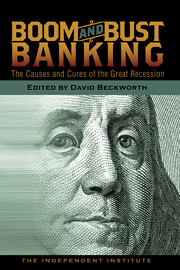Many Americans rang in the New Year with heightened anticipation, as the halls of Congress were bustling in the waning hours of Dec. 31, 2012. While legislators managed to ink a deal just before the deadline and curtains closed on the year, the economic stakes from the fiscal cliff unfortunately overshadowed any close examination of whether allowing the Bush tax cuts to expire and letting spending cuts pass would push us into another recession in 2013.
Writing about the cliff, Paul Krugman warned that “bringing down the budget deficit when the economy is already depressed” would make “the depression deeper.” International Monetary Fund managing director Christine Lagarde has raised the same worry, citing forecasts of the cliff’s effects based on Keynesian assumptions. On those assumptions, spending cuts and tax increases depress the economy because they take money out of people’s pockets. The affected people spend less money, the people who would have received their spending as income do the same, and pretty soon we are in another recession.
There are indeed reasons we fought to avoid falling off the cliff. The comprehensive increases in taxes on capital formation, for example, would do long-term damage to the economy. However, I argue that concerns about the fiscal cliff would have been needlessly exaggerated if the Federal Reserve had stabilized nominal spending. For that matter, Congress could have voted to cut spending much more deeply than our current legislation allows for, and without risking another recession.
The onslaught of the Great Recession of the 2000s began with unsustainable economic growth that followed the 2001 recession. When the economy began to contract in 2008, the Federal Reserve failed to act responsibly. By effectively tightening monetary policy, it “leaned with the wind” instead of against it. This response turned what was initially a mild recession into the Great Recession.
As I discuss in my new book, Boom and Bust Banking: The Causes and Cures of the Great Recession, total federal expenditures, measured in dollars, have been spiraling downward since mid-2010. The budget deficit as a share of the economy has fallen more than 2 percent over this time. This fiscal tightening has taken place in the midst of a barrage of economic shocks including the Eurozone crisis, the 2011 debt ceiling talks, and concerns about an Asian economic slowdown that have kept economic uncertainty elevated. Yet nominal spending has been incredibly stable, growing at about 4.5 percent a year. The recovery has been sluggish, but the Fed appears to have kept fiscal contraction and other economic shocks from ending the recovery.
The Fed could counteract the effects of this fiscal crisis, too. It could best do this by explicitly adopting a nominal-spending target. The more credible that target, the less the Fed would have to do to reach it: Private-sector expectations of future spending powerfully influence current spending levels. Knowing that the Fed would do whatever it takes, including aggressive open market operations, to maintain steady nominal GDP growth would create confidence and more economic certainty for households and firms—regardless of whether the government was cutting spending. The effect should be to offset every dollar of reduced government spending by roughly a dollar of increased private spending.
The Fed cannot undo the effects of any bad policy Congress enacts. It can’t, for example, restore incentives to work, save, and invest if legislators stifle them. What the Fed does have the power to do is to keep the Keynesian nightmare from taking place. We may have temporarily averted the fiscal cliff, but it still looms in the distance. The threat of another recession is real, but if it comes, it will be because the Fed failed to do its duty.








